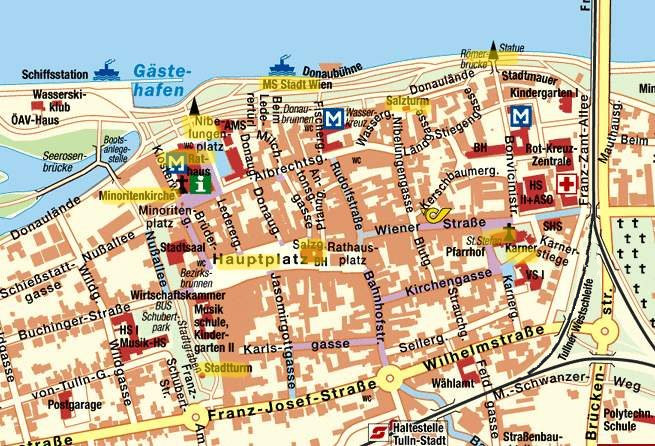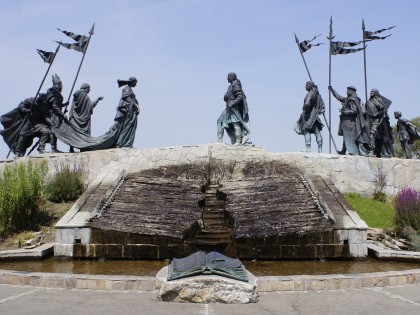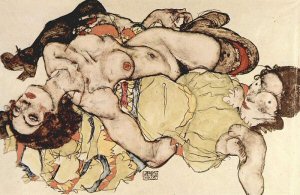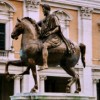The history of Tulln is as long as it is moving! It began more than 2000 years ago with the Roman equestrian camp "Comagena", which, like all
Roman foundations, was built on the right bank of the Danube. Still today you can admire the well preserved Roman tower (salt tower) on the Danube bank.
The ground plan of the complex, which existed until the 5th century, can be seen in the structure of the old town. Tulln gained great importance during the time of the
Babenberg Margraves as a residence and Danube trading centre.

Discover (with the mouse) the yellow marked sights on the city map of Tulln!
click here to go to the Tulln photo gallery

This statue is a copy of the famous equestrian statue of the Roman Emperor Marcus Aurelius (161-180 AD), which stands on the Capitol in Rome.
It was created by Mikhail Nogin and placed on the Danube in 2001. The statue is intended to commemorate the centuries-long presence of the Romans on the Danube border.
Many a Danube cyclist has leaned his bike against the pedestal of the statue and taken a photo. For comparison the original in Rome. (click on the small pictures to enlarge!).

The late Romanesque Tullner Karner behind the church of St. Stephen's dates from the Babenberg period.
The building was erected around 1240/50, probably by order of the last Babenberg duke Friedrich II. At this time, however, the residence of the Babenbergs was already in Vienna.
The ground plan of the carnival is 11-angular, a form that goes back to the Church of the Holy Sepulchre of Christ in Jerusalem.

Until 1785, the basement of the Karners served as an ossuary for the exhumed bones of the cemetery.
On the upper floor there is a cemetery chapel, into which you can enter via the new outside staircase and which you enter through the magnificent Romanesque funnel-shaped portal. Although the apse faces east, the portal swings to the northwest, apparently towards the southern gate of the Roman camp, which was still in use at the time.

According to the Song of the Nibelungs, the Hun king Etzel Siegfried's widow Kriemhilde was received in Tulln, an event to which a monument in the form of a fountain on the banks of the Danube was dedicated in 2005.
The bronze sculptures are the work of the sculptor Michail Nogin.
See
more pictures of Tulln in the photo gallery

One of the famous sons of the city is the painter Egon Schiele (1890 - 1918), a representative of expressionism. He was born on 12 June 1890 in the building of the main station in Tulln.
The museum in the old prison building of the district court of Tulln was opened on June 12, 1990 on the occasion of the artist's 100th birthday. It contains a detailed documentation, dedicated to the life, the family and the complete works of Egon Schiele. His works on Wikipedia.

Egon Schiele, reclined woman, 1915


Danube cycle route

